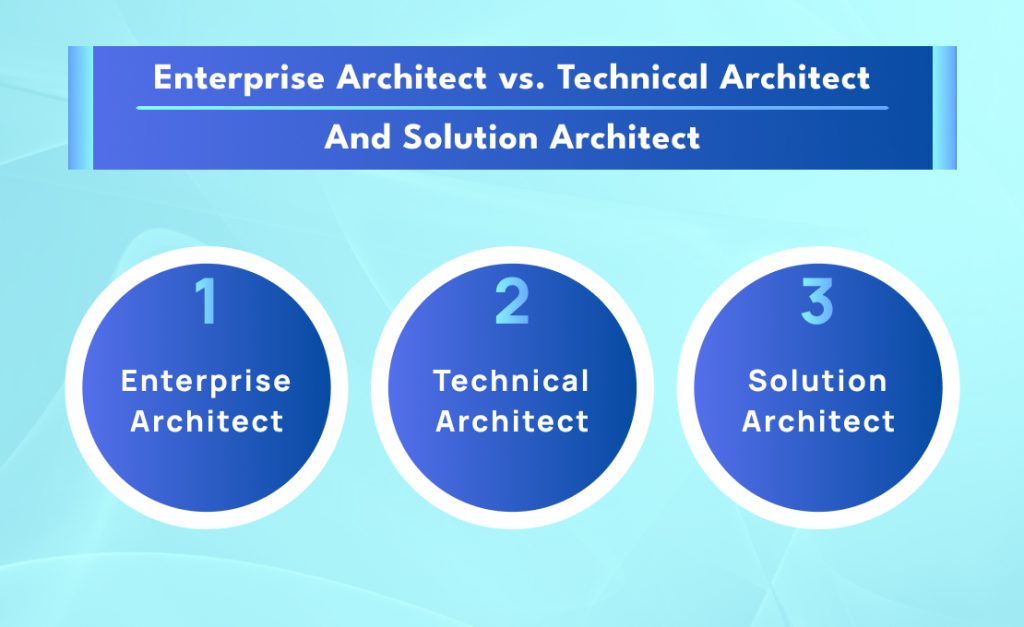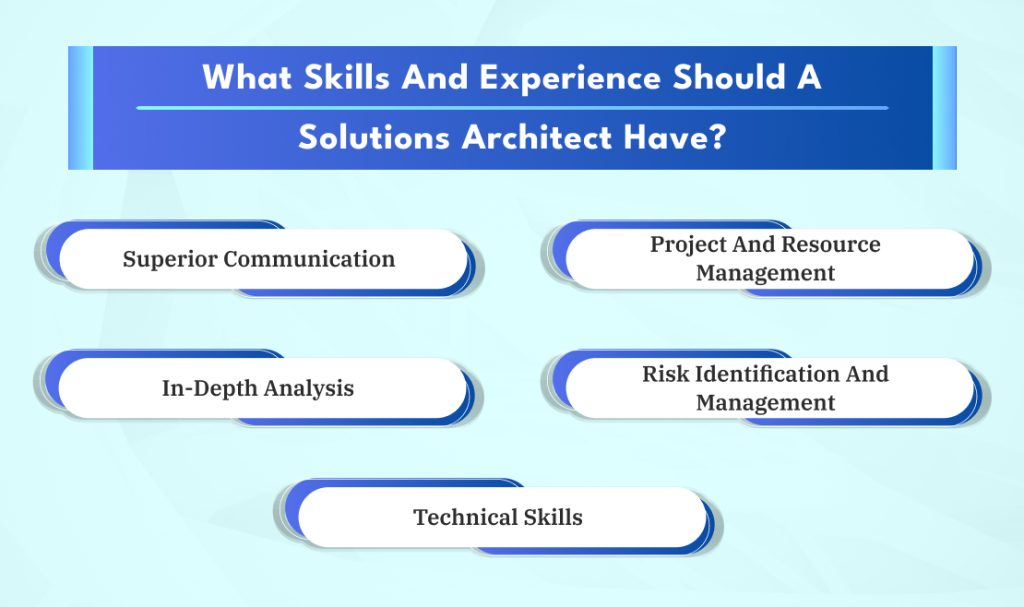Today, technology constantly evolves. Envisioning a prosperous enterprise without a solid software base isn’t easy. So, enterprises and businesses across the globe increasingly face the necessity of becoming digital. They must adopt innovations and high-end technology to boost their work and continue to grow. A complete digital transformation requires specialized capabilities and knowledge to ensure that the business’s needs align with the planned technological options. Thus, the expert is crucial to making this occur.
It is essential to identify the architecture for solutions to clarify the subject. For Software development, an architectural model describes both the design of the software that will be developed and the design of creating it to meet the client’s needs and address specific issues. The definition might seem ambiguous and generic, but it’s because each customer’s problems are unique, so they need different solutions. Usually, they do so that requires a specific strategy.
The idea of a solution architecture is quite complicated and covers a wide range of aspects for developing a custom software program with a distinct objective. Many architectures deal with different functional requirements and non-functional needs and details. They include, for instance, security, business, information systems, technologies, and many more.
Let’s examine the job description for a solution architect by shedding light on the fundamental duties, roles, and specifications that make up this crucial position within the world of technology.
What Exactly Are Solution Architects?
The solution architects are responsible for designing and implementing comprehensive technology solutions that satisfy business requirements. They bridge business and technical aspects to ensure solutions are aligned with the company’s objectives—a deep knowledge of different technologies. Solution architects collaborate with the developers, stakeholders, and other IT experts to develop an efficient and cohesive solution that meets the company’s demands.
With a clear understanding of the entire project and a thorough knowledge of the requirements, a solution architect outlines the software system’s components and how they will interact. The specialists begin the process very early, setting out the plans for what’s coming. They usually start by picking the best technology for the company problem(s) and managing architecture concerns to produce the most efficient and productive results.
The architect is accountable for conveying the design vision to the development team and has a crucial role in the development process. They are also involved in subsequent software updates. One of the primary motives for a business to hire this professional is to effectively create and implement new technology solutions that meet its company’s needs. Also to bridge the communication gap between non-technical and technical experts involved in a project. Since the procedure is expensive and risky, every business should employ an architect who can implement innovative strategies and scale them up successfully. A specialist in this field can be brought to the company’s design and structure by consulting on software architecture services.
Enterprise Architect vs. Technical Architect And Solution Architect

The IT industry is centered around three distinct areas of responsibility when it comes down to building. While there’s a bit of blending, each is distinct and has specific requirements and duties. Enterprise architects are responsible for the general IT plan and the organization’s architecture. Technical architects manage technical infrastructure, and solution architects focus on implementing specific solutions that meet business requirements.
This is a comparison analysis of three roles in enterprise architecture. Technical architect. The solution architect.
Enterprise Architect
An enterprise architect is responsible for a company’s business operations. His work mainly focuses on developing and implementing technology solutions that address business and strategic issues. The main goal of Enterprise architects is to create an efficient SDLC by efficiently utilizing the available resources to construct an effective enterprise structure that is a perfect fit for every technology asset.
Technical Architect
The seamless implementation of the latest tech assets, technological advancement, and the development of a solid software architecture all fall within the concept of technical engineers. The primary task of the technical architect is to be decisive as he oversees the most critical parts of the software being created.
The technical architect works closely with the software development team and analyzes IT strategies. They are accountable for documenting the procedures each team member must follow during development. The main difference between a technological architect and a solution architect is that a solution architect is focused more on engineering fundamentals, whereas technical architects are focused on both.
Solution Architect
Solution architects are more involved than their technical and enterprise counterparts. Their job is to translate business requirements into Software Development Services while taking advantage of the latest trends within the tech industry. It’s interesting to know that every architectural role is interconnected, and some businesses even combine more than one of these jobs into one post. Architects cannot clearly define their duties today. They typically work as a team player, combining technical solutions and enterprise roles.
Importance Of Solutions Architect In A Company
As companies expand and technology becomes more integral to their business and processes, the job of the solution architect becomes vital. They bring knowledge and expertise to the table and aid companies in making the right strategic choices that will lead to lasting success.
One of the primary reasons why having an architect of solutions is essential is that they assist you in navigating the complicated technological landscape. They will analyze the organization’s infrastructure to identify areas for improvement, like consolidating databases or updating old software. This does more than help companies reduce time and costs; it assures them they’re using the most advanced technology to satisfy their requirements.
Additionally, an architect of solutions can offer valuable insight into new trends and technology. They will help companies remain ahead of the game with technology and tools that can assist them in improving their customer service and streamlining their processes. By designing systems that quickly adapt to changes in customer’s requirements for their business or requirements, solution developers ensure that the technology solutions they provide remain current and effective. So. If you’re in a running company that wants to be on top of trends, employing a solution architect is an investment that will benefit you over the long haul.

Optimize Your Operations with Our Custom Software Solutions!

Pooja Upadhyay
Director Of People Operations & Client Relations
Job Responsibilities of The Solution Architect
Solutions architects are responsible for establishing a thorough design for software solutions and providing direction and strategic guidance throughout development. The person in charge must ensure that the solution is incorporated into an enterprise’s existing architecture from a business and technical perspective. They work with the various team members involved in the creation process and must understand how each product or service functions within the framework of solution design. Professionals need all the expertise to produce an excellent final product for their clients.
As the title suggests, this expert focuses mainly on decision-making at the solution level and assessing its impact on a company’s broad goals and results.
The job of the solution architect includes a variety of tasks. This includes:
Defining Solution Architecture
Solution architects create and record the general architecture of technologies while ensuring they align with the business goals and needs.
Needs For Gathering
They work with key business people, such as analysts, project managers, and end-users, to learn about their clients’ needs and gather specifications for the solution.
Evaluation Of Technology And The Selection Process
Solution architects evaluate various technologies and platforms to identify the best options for the application, considering factors like price, performance, and compatibility.
Technical Guidelines
They provide expert technical advice and guidance to development teams, help them implement the solution efficiently, and troubleshoot any issues.
Securing Performance, Scalability As Well As Security
Solution architects must ensure that their design solution meets the required performance, scalability, and security requirements, including reviewing any possible threats or weaknesses.
Identification Of Risks And Mitigation
They’re accountable for identifying potential risks and concerns with the solution and implementing appropriate measures to reduce them while ensuring the project’s success.
Continuous Improvement
Solution architects constantly look for improvement possibilities and help develop technology solutions. They also stay abreast of industry developments and the best techniques.
Effective Communications
They must possess excellent communication abilities and work closely with various project team members to coordinate the project’s success.
What Skills And Experience Should A Solutions Architect Have?

The successful solution architect will be able to demonstrate various capabilities, such as Cloud Consulting Services, knowledge of technology, business savvy, and strong interpersonal skills. The most essential requirements for this position are:
Superior Communication
Communication skills with project managers, developers, stakeholders, and software vendors involved in the development process are vital for any solutions architect. Because architects play the primary role of any project and are the leaders of every group, improper communication could lead to massive delays. This specialist must be able to clearly explain how to comprehend everyone’s point of view, be able to listen, give advice, and be influential.
Project And Resource Management
While solutions architects may not be directly involved in development, they must ensure that project resources are utilized efficiently. They must be knowledgeable and able to identify the most efficient approach in every element of architecture. Their job is to concentrate on the business objectives, such as hiring new staff and figuring out how to meet them within a specified timeline and budget.
In-Depth Analysis
Systems and software that are integrated within it have a myriad of details that work in tandem. A designer must be attentive to these particulars since ignoring something could hinder development, cause problems, or cause the software to become inadequate. Also, they must be aware of various software and hardware technical specifications and conduct analyses of various business layers. They are also accountable for the context of the project right from the start to the present moment. They must keep track of every detail of plans and concepts to verify and approve the project on a date.
Risk Identification And Management
A good architect should be skilled at analyzing and determining potential short- and long-term risks that could create technical problems and hinder businesses shortly.
Technical Skills
As one would expect, the job of a solution architect demands the ability to learn and knowledge of all the significant aspects of software development in addition to technical expertise in hardware (for software development projects that depend upon hardware).
Fundamental Processes In Solution Architecture
When it comes to software applications, architecture is a set of processes executed at the same time or in stages. The processes involved are primarily in line with the responsibilities of solution architects, as discussed in this article. We’ll quickly review one of the most crucial:
Analysis
Establishing and comprehending business requirements, the infrastructure in place, and the solution’s primary purpose is crucial.
Evaluation
An architect assesses the software tools’ potential and makes the best selection.
Design
An architect’s primary responsibility is constructing an architecture for a solution. This involves drawing the plan for the future solution and mapping out its construction and integration steps.
Supervision
The process partly doubles or enhances a manager’s role for projects and ensures that the development team adheres to the business and design needs.
Documenting
The architect’s design should be adequately documented to ensure that the team developing it can follow it. Thorough and precise documentation will benefit developers and customers during and after the product’s release.

When Should You Hire a Solution Architect?
A typical business requires an architect to develop, design, or implement a sophisticated technological solution to address a specific business issue or accomplish a particular objective.
One of them is:
The Ideation Phase
Solution architects are essential in constructing and implementing software systems that meet customers’ business requirements and help all the infrastructure work at the highest capability and efficacy. Therefore, architects should be involved with the project before the design and development process begins. An architect’s expert analyzes and calculates the first requirements and analyzes the technical aspects of the proposed project. They also make the specifications transparent, communicate with other stakeholders, and ensure the client gets the best solution.
If You Are Making Your MVP Or PoC For Your Investors
The solution architect will suggest the most efficient combination of technology and tools to fit the budget. Additionally, the specialist can assist in translating the complex technical language to one that is easy and understandable for people who invest in businesses, i.e., into the “money” language.
Before Starting the Process Of Developing
Along with constructing the design, a solution architect should ensure everyone on the Offshore Development team comprehends their needs and roles. In addition, since they are the team’s most crucial member, the architect must use their knowledge and ability to manage the process of building products to make it as easy as possible. The job of an architect is highly demanding and demands in-depth knowledge and experience in various IT-related areas. The need for such specialists is expected to become even more sought-after as time goes on due to ever-changing techniques and emerging trends in the industry.
Conclusion
In essence, the solution architecture represents software that ensures the program meets the customer’s demands. This is among the primary steps toward making an enterprise-level technology asset or software built on time-tested and goal-oriented procedures.
Solution architects comprise numerous domains that form the foundations of IT. They are IT specialists and managers whose mission is to design large-scale infrastructure plans and initiatives that achieve their goals, enhance the efficiency of systems, and implement solutions. They’ll work with EAs, TAs, business architects, and others. To develop a state-of-the-art architecture for the future. The IT architect and his teams tackle various elements of the life cycle of a project and plan, devise, and plan the development of enhanced processes and capabilities for business and software. This synergy is essential to build a lasting, efficient enterprise structure.
FAQ
Let’s look at a few of the most commonly -asked questions
A solution architect for IT is an expert responsible for constructing the complete architecture of an upcoming software application. Additionally, they must define a specific strategy through all phases of software development.
This expert is accountable for ensuring that the new solution meets the requirements of both business and user demands. They supervise the implementation of the high-quality solution. They must know the goal and objectives to produce efficient and successful results.
Solutions architects design and develop IT structures compatible with the specified business needs. Their job begins by considering the requirements, understanding the specifications, analyzing the existing systems currently in use, and cooperating with other key stakeholders to design the best solution.
In general, the solution architect’s task is to present the business needs to the development team and assist them in creating an application that efficiently solves actual business problems. This essential job demands a wide range of IT abilities and expertise. As companies increasingly depend on the latest technologies and software, the role of an IT expert will continue to increase.
Hiring and finding an architect matched to your solution is challenging since the demand for highly skilled professionals is immense. If you are looking to employ an internal employee, finding them may take some time since finding experts in your region is difficult. But if you’re looking for new jobs and would like to hire a remote team member, you will have a better chance of finding the perfect candidate.
We recommend a reputable outsourcing provider with experience recruiting software development experts. They give you access to an extensive expert pool of talent. Additionally, you can concentrate all of your efforts on the business requirements, and the company will take care of recruiting and provide you with experts to select from.
The pay of a solution architect can vary greatly and is contingent upon several variables. The first is that the area of employment for specialists plays a crucial aspect. Furthermore, salary is determined by many years of expertise, technical expertise, seniority, and soft capabilities.

Unlock Your Tech Potential: Hire a Dedicated Software Developer Now!

Pooja Upadhyay
Director Of People Operations & Client Relations


